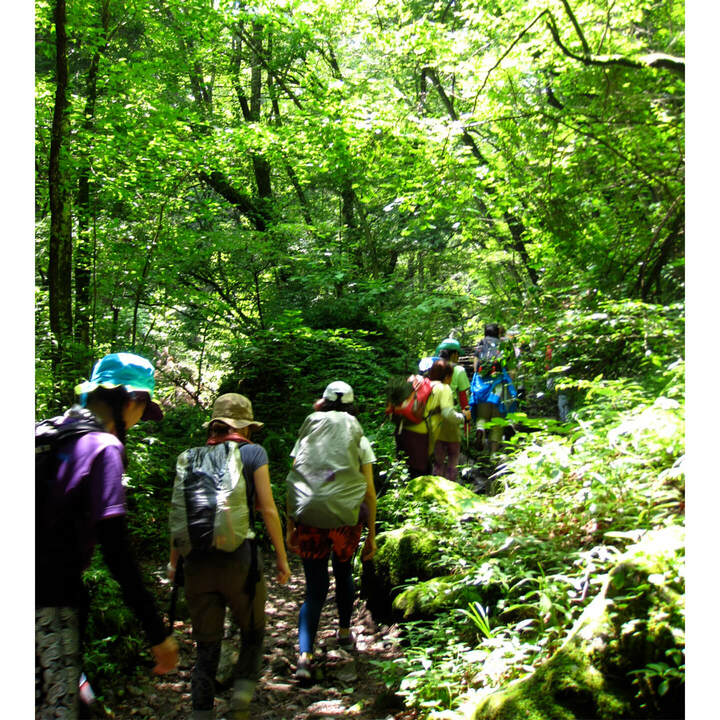 Yoga is usually done at home or in a studio. In order to enjoy such an ordinary yoga practice even more, why not venture outside during the pleasant season and do it on a mountain? Mountains are especially cool in summer and are a good place to escape the heat. So, in order to enjoy yoga more, we will learn from a mountain yoga professional about the real thrill of longing for mountain yoga, how it differs from regular yoga, mountain yoga fashion, and what kind of things one should keep in mind when doing mountain yoga for those in their 40s, including mountain climbing.
Yoga is usually done at home or in a studio. In order to enjoy such an ordinary yoga practice even more, why not venture outside during the pleasant season and do it on a mountain? Mountains are especially cool in summer and are a good place to escape the heat. So, in order to enjoy yoga more, we will learn from a mountain yoga professional about the real thrill of longing for mountain yoga, how it differs from regular yoga, mountain yoga fashion, and what kind of things one should keep in mind when doing mountain yoga for those in their 40s, including mountain climbing.
What is mountain yoga?
By the way, what are the characteristics of mountain yoga compared to regular yoga? Are the asana, or yoga postures, different from those of regular yoga? There are no specific rules regarding asana in mountain yoga. If you are in a flat, spacious place, you can start with shavasana. You may simply lie down on the ground and look at the blue sky. You can even take off your shoes and start by relaxing your toes.
As for the time, you should not think of doing it for dozens of minutes like in a studio lesson, but should feel free to do any pose you like, depending on how you feel when you stand on the summit of the mountain. Standing on the mountaintop, you will naturally want to spread out, so I recommend poses that spread your chest out. Also, since the wind can be strong and the temperature low on the mountain, vinyasa-type poses that warm the body are also good, rather than relaxing poses. In any case, the choice of poses depends on the situation.
A yoga mat may be brought if the mountain is cable accessible, but a single leisure sheet is sufficient. If you don’t have a sheet, you can just do standing yoga.
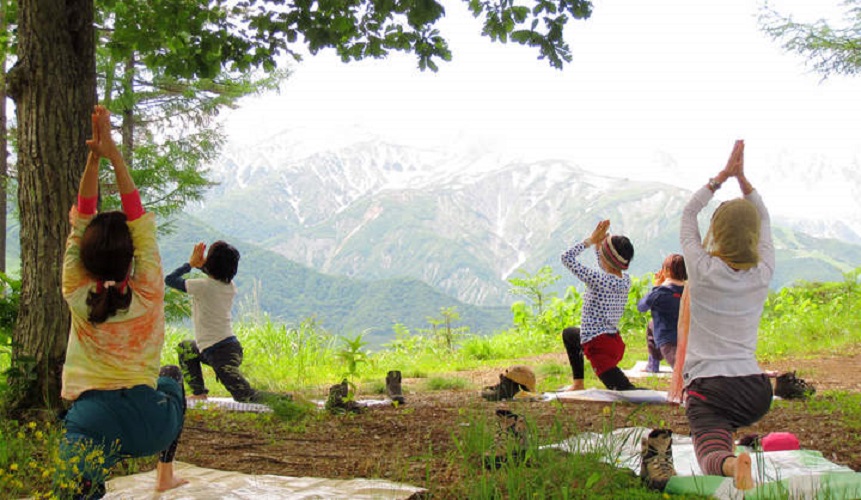 Attractions of Mountain Yoga
Attractions of Mountain Yoga
You can experience the elation of mountain climbing and the relaxation of yoga at the same time
Climb to the top of the mountain with your breath held high, and then relax your body after a good amount of fatigue with yoga. By combining mountain climbing and yoga, you can enjoy both a sense of accomplishment and comfort.
The sense of openness and ultimate relaxation
Mountains are open places where there are no ceilings, walls, or floors to block your awareness. Doing yoga in the mountains is an invigorating way to free your mind and body. The air is also fresh. The sensation of expanding one’s body in such an environment is something that is hard to experience in everyday life. It is the ultimate relaxation and purification of the body and mind.
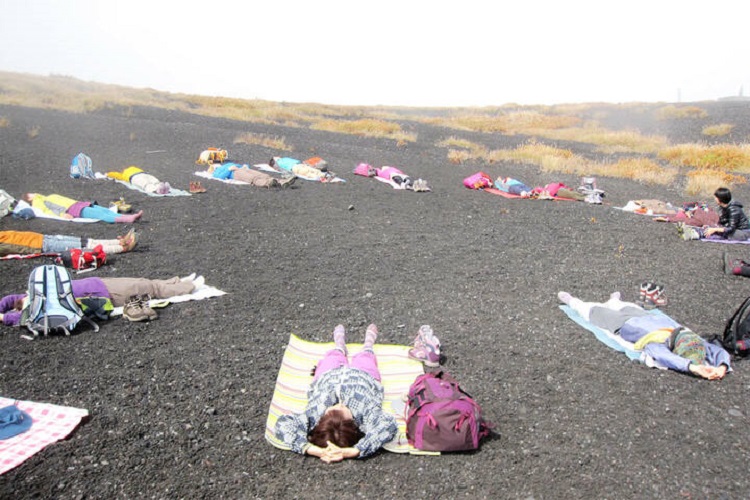 Enjoying the Beauty of the Landscape from 360 Degrees
Enjoying the Beauty of the Landscape from 360 Degrees
In yoga poses, the direction of the body (line of sight) changes in various ways, such as back and forth, left and right, and rotation. One of the best parts of mountain yoga is that you can enjoy the view of the mountain from various angles while doing yoga. Fuji between your legs, the blue sky, or looking down at the sea of clouds while doing the poses, you will feel as if your perspective on things will change as well.
Breathing becomes deeper
Breathing tends to become shallow when you work all day in a building, live your daily life in a dense city, or live in a complicated relationship. On the other hand, when we are surrounded by magnificent mountains and see the endless expanse of earth and sky, we naturally want to breathe deeply and spread our arms and legs as wide as we can. Yoga deepens and facilitates this action.
Relieves fatigue from mountain climbing
Resetting the overworked body through yoga will relieve the fatigue of mountain climbing. It will take away not only the stiffness of the body but also the stiffness of the mind.
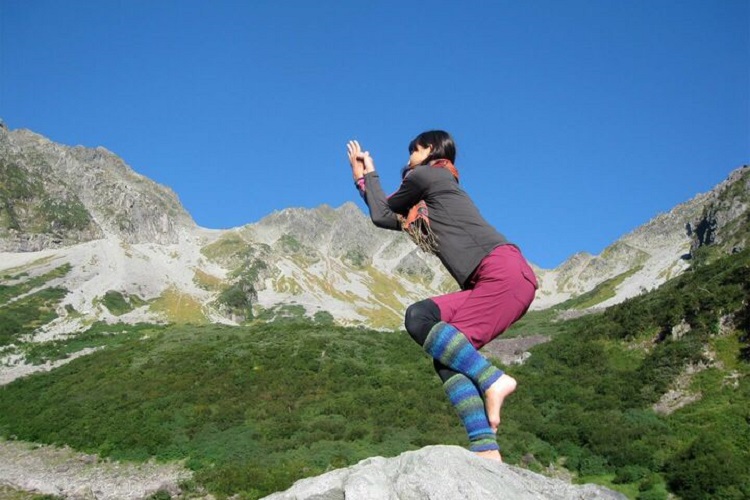 Become aware of the connection between people and nature, mind and body
Become aware of the connection between people and nature, mind and body
When you go to the mountains, you may encounter living creatures and plants that are nurturing their lives in the harsh natural environment. When we encounter such mountain scenery while hiking in the mountains, we feel that people are part of nature. It makes me want to cherish the nature that we have now. The word “yoga” comes from the Sanskrit word “yuju,” which means “to connect. Mountain yoga is one tool to connect people with nature and with their own mind and body.
Effects as Total Fitness
The effects of hiking in the mountains are to improve cardiopulmonary function, muscle strength, and endurance. On the other hand, the effect of yoga is to move every inch of your body, circulate throughout your body, and balance your body. At the same time, it relieves excessive muscle tension and smoother the movement of joints. By doing both mountain hiking and yoga, you can achieve a comprehensive fitness effect.
Mountain yoga in summer is cool!
It is said that as elevation increases by 100 meters, the temperature drops by about 0.6 degrees Celsius. In other words, if you climb a mountain at about 1,000 meters, the temperature will be about 6 degrees lower than on level ground. Even if it is midsummer and the temperature on the plains is over 30 degrees Celsius, it is relatively comfortable on top of a mountain. If the wind blows, the temperature is even lower. Depending on how high up the mountain you climb, it can even feel cold in the summer if you are on a high mountain.
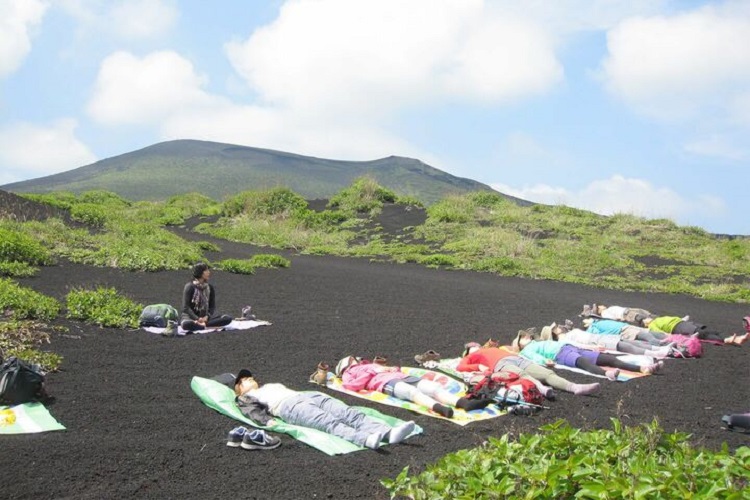 Points to Keep in Mind When Doing Yoga in the Mountains
Points to Keep in Mind When Doing Yoga in the Mountains
Warm clothing is a must!
And then there is the fashion for mountain yoga. How should you choose your clothing? As long as it is in a style that allows you to climb mountains, you can wear whatever fashion you like. However, while it gets quite hot during the climb, as soon as you stop climbing, your body suddenly cools down, so you need to wear warm clothing even in summer to avoid sweat chill. A light windbreaker, light fleece, or light down jacket will help. Also, be sure to pack rain wear, as the weather in the mountains can change quickly. Poncho-type rain wear will be blown away by the wind, so we recommend that you wear a jacket and pants with separate upper and lower layers.
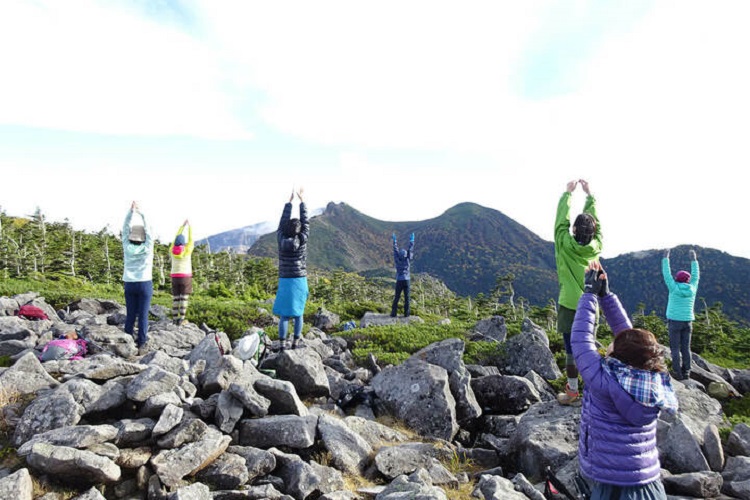 Sunburn Prevention
Sunburn Prevention
Mountain yoga is a great way to enjoy both mountain climbing and yoga. Since you will be spending all day in the sun, UV protection is essential. Basically, sunscreen will do the trick. If you are concerned, reapply frequently after each break. We also recommend wearing sunglasses to protect your eyes from UV rays. Other recommended items include a UV-proof hat, a breathable neck warmer, and a scarf.
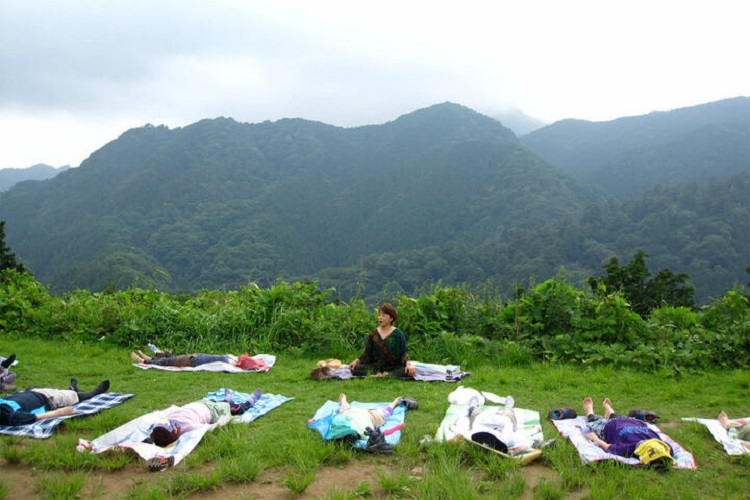
Yoga refreshes both mind and body. On a mountaintop, it will be even more effective and naturally more intense. However, balance poses should be done only after making sure you are in a safe place. Also, don’t try difficult poses on dangerous rocky terrain. Since yoga is performed in a natural environment, safety is the first priority. Also, there are other climbers on the summit, so please be considerate and do not occupy the place for a certain amount of time.

